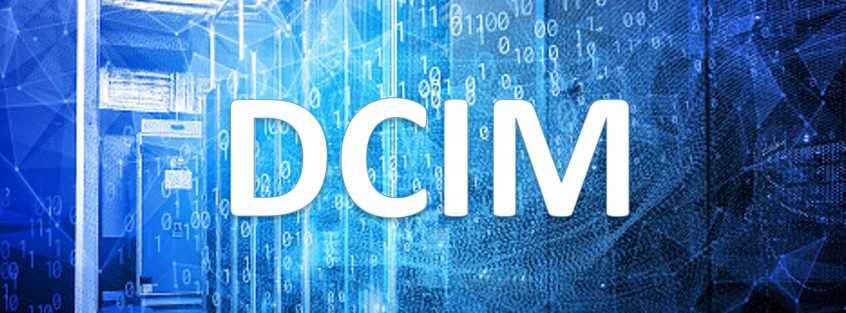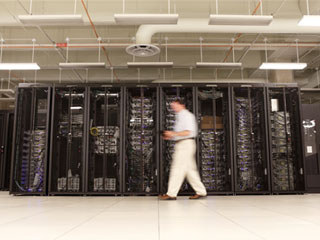The discipline of controlling and optimizing the operations and performance of your data center infrastructure through software is known as data center infrastructure management (DCIM).
The Complicated Datacenter Infrastructure Management
Demands for computing resources have been evolving since corporate organizations embraced networked computing systems.
In recent decades, scalability, performance, security, and operational needs have compelled data center administrators to make frequent updates to the underlying infrastructure. New hardware replaces old as technology advances to meet the rising demands of cloud computing and online streaming services, while IT struggles to manage the hybrid mix of new and older data center systems.
A purpose-built enterprise-class data center management suite was required due to the lack of a fully integrated control system for hardware assets. That is where DCIM software came in. Growing from network management platforms such as AKCP, they expanded into doing much more than managing and monitoring network-attached equipment.
What Is DCIM’s Role?
DCIM is a software solution that provides the procedures and tools needed to manage data center infrastructure in a systematic manner. You often hear the term “from a single pane of glass”. This means, from one screen all your data center assets, infrastructure, network, environmental, and power conditions are available.
The system also aids IT in optimizing computing resource availability in response to changing demand, as well as capacity planning for expansion.
DCIM technology employs a set of essential parameters that take into account virtual instance performance, automatically matching activities between resource demand and supply.
Parts Of DCIM
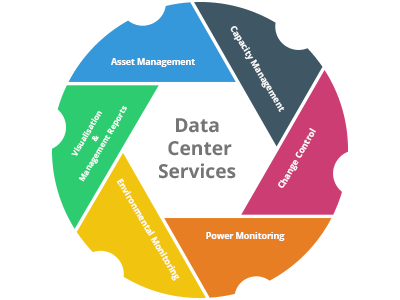
Photo Credit: www.thinglink.com
DCIM solutions are made up of a number of different components. At the infrastructure layer, they serve a range of enterprise IT tasks.
Physical Structure
A data center’s floor space is allocated based on the following criteria:
- The equipment’s physical size
- Cooling and airflow
- Accessibility to humans
DCIM technology aids you in visualizing and simulating the representation of server racks installed in the data center, allowing you to assess if the actual space is adequate.
Rack Design
In most cases, you’ll deploy server and networking technologies in your data center using standardized cabinets. Understanding the nuances of rack design may assist data center operators in planning for capacity, space, cooling, maintenance, and troubleshooting.
Based on these considerations, DCIM may assist in the selection and placement of server racks.
Materials Catalog
Large libraries of equipment materials are available using DCIM technology. Basic parameter definitions for high-resolution renderings are all included in the data. With the fast introduction of new technologies in the industry, these libraries are updated and maintained on a regular basis in collaboration with the manufacturers.
Change Management
For a variety of reasons, data center gear must be updated on a regular basis:
-
The inherently limited lifecycle of hardware
-
A malfunction
-
The need to upgrade to a better product
However, this modification may have an impact on the performance of other integrated infrastructure technologies. DCIM helps IT to take a systematic approach to manage such hardware changes, allowing them to:
-
Following predefined process workflows
-
Reducing the risks associated with the change
Planning For Capacity
The data center should be scalable to meet changing business requirements. As a result, your capacity planning must take into account:
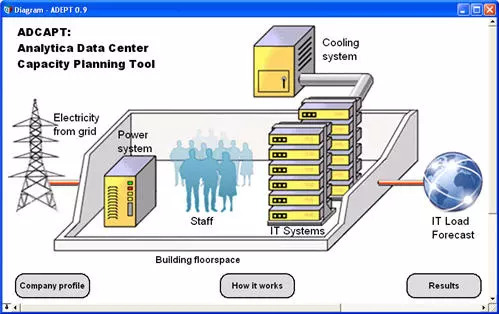
Photo Credit: lumina.com
-
Space limitations
-
Weight of equipment and racks
-
Power supply
-
Cooling performance
-
A range of other physical limitations of the data center
The DCIM program can simulate a wide range of future/potential situations, allowing you to design future capacity depending on these constraints.
Integration of Software
DCIM systems are meant to track and coordinate data center assets and activities and are linked with current management solutions. The following are examples of integrations:
-
Protocols such as SNMP and Modbus
-
Complex web integrations
Analyzing Data
DCIM technologies rely heavily on real-time data collecting and processing. You may use a DCIM tool to:
- Keep track of a wide range of asset parameters.
- Web-based APIs are used to transfer data across DCIM systems.
- Utilize sophisticated AI technologies to analyze data.
Looking at the indicators’ real-time performance can help you prevent issues like power failures, security breaches, and network disruptions before they happen.
Dashboard And Reporting
A competent DCIM solution can turn massive amounts of logged data into easy-to-understand dashboards and reports. Using the reporting data, automated actions may be initiated and examined for further research.
Vendors And DCIM Capabilities
These features may be supplied through a variety of software modules and solutions from a variety of suppliers and combined into a full DCIM suite.
The following are some of the most well-known DCIM providers:
How To Begin Using DCIM
Moving from traditional spreadsheet planning to a full-fledged DCIM suite may require a rethinking of how data center assets are managed.
Adopting DCIM solution modules in stages is a solid starting point: start with the bare minimum and gradually increase capabilities.
AKCP DCIM Solutions
Whether you are looking for a few temperature and humidity sensors for your computer room or rolling out a multi-cabinet monitoring solution, AKCP has an end-to-end data center monitoring solution including sensors and our own DCIM AKCPro Server software. Our Rack+ solution is an integrated intelligent rack or aisle containment system. Cabinet Analysis Sensor (CAS) checks proper air pressure gradients between hot and cold aisles. RFID Cabinet locks secure your IT infrastructure.
AKCP is the world’s leader in SNMP-based Data Center Monitoring Solutions. With over 200,000 installations worldwide, you can count on us to monitor and protect your Data Center.
AKCP Sensors

AKCP CABINET AND THERMAL SENSORS
With AKCPro Server installed, dedicated rack maps displaying Cabinet Analysis Sensor data can be configured to give a visual representation of each rack in your data center. If you are running a hot/cold aisle containment, then containment views can also be configured to give a sectional view of your racks and containment aisles.
This configuration of sensors monitors the air intake and exhaust temperatures of your cabinet, as well as the temperature differential from the front to the rear. Datacenter monitoring with cabinet sensors helps identify and eliminate hotspots by identifying areas where temperature differential between front and rear are too high.
AKCPro Server
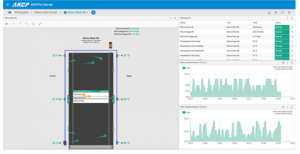
AKCPro Server
AKCP Pro Server is a world-class software for Data Center Infrastructure Management. Avoid the complexity and cost of many popular Infrastructure Management software. AKCPro Server distills the essence of what DCIM should be into a simple, easy-to-use application. Configure dashboards to display the data you need, with drill-down mapping taking you from a data center-wide to a cabinet-level view. A dedicated rack map shows smart rack sensors such as thermal maps and RFID Swing Handle lock information in a graphical display. Example of cabinet rack view with cabinet thermal map sensors in AKCP Pro Server.
Reference Links:
https://datacenterfrontier.com/data-center-infrastructure-management/
https://www.sunbirddcim.com/what-dcim
https://www.nlyte.com/solutions/data-center-infrastructure-management-dcim/
https://www.deltapowersolutions.com/en/mcis/data-center-infrasuite-manager.php

